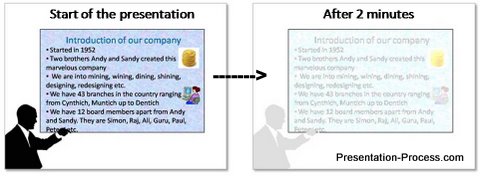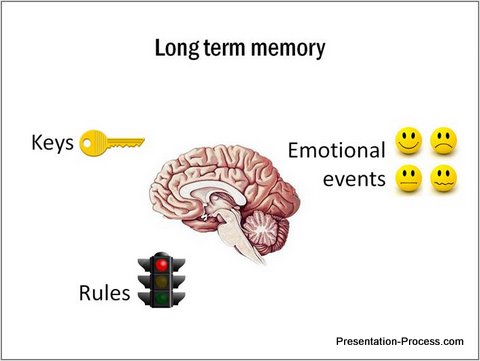Home > Presentation Tips > Make a Presentation that Sticks
How to make a presentation that sticks in your audience’s mind?
How to make your message hard to forget?
This article will provide you the answers. But before that, you need to know how your brain processes information. Without that knowledge, you can’t structure your message in a memorable way, for your audience.
Your brain is highly selective
Do you know that every second, your brain receives 4 million pieces of information?
If you were to actively process all that information, you won’t remain sane for long. So, your brain chooses to process no more than 40 pieces of information per second. Which means, for every piece of information you take in, you reject 100,000 others as ‘junk’.
If your presentation is not interesting, you become invisible
If your presentation is not seen as more interesting than 100,000 competing information hitting your audience simultaneously, you will become invisible to your audience.
How the presenter becomes invisible

All the hours you spent creating your presentation will go down the drain and your boring slides will cost you in terms of lost business.
Making Interesting slides is just the first step
It helps your audience notice your slides and your information enters their working memory. Working memory is like a scribbling pad. They may note your information, but they won’t retain it for more than 3 minutes.
So, just because your audience is smiling and nodding you don’t assume that your message will be retained for long.
How to make your message memorable?
Your audience is very selective in deciding what information they allow to enter their long term memory.
They allow just 3 types of information to enter their long term memory. They are
- Keys
- Rules and
- Emotional events
What Audience Remember

Visual Presentations eBook
From text-based slides to simple & visual diagrams in 3 easy steps. Multiple before and after examples!
Presentation-Process.com/Visual-eBook
Let’s understand them in detail.
Keys:
Keys are nothing but solution to their problems. If your information solves your audience’s pressing problems, you can be sure that they will remember your message for long.
Rules:
Rules are the norms they need to follow to remain safe. For example, you’ll always remember traffic rules, because when you forget the rules you’ll put your life at risk.
Emotional events:
Emotional events are the moments with significant personal meaning. For example, you remember your first date or your first accident and the emotions attached to the event. Don’t you?
What does this information mean to you as a presenter?
If your presentation is not structured as solution to your audience problems or as set of rules they can’t afford to violate or as an experience they can’t forget – your message won’t stick.
So, if you want your presentation to stick in the minds of your audience, you must structure your presentation to aid their long term memory. You must give it in the way they like to absorb.
Here is your action step.
Get back to your work table and take a fresh look at the presentation you just made. Is it structured to stick? If not, it’s time to learn the skill.
You can learn how to make a presentation that sticks, by going through our Minimal® process for making presentations. This site is full of useful information to help you as a presenter.
Return to Main Presentation Tips Page
